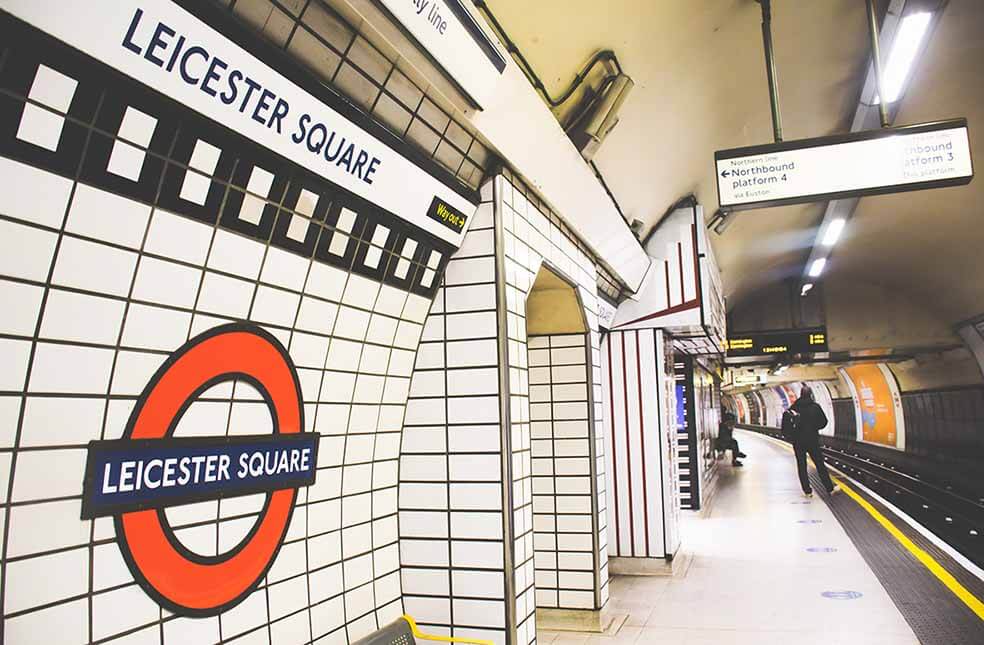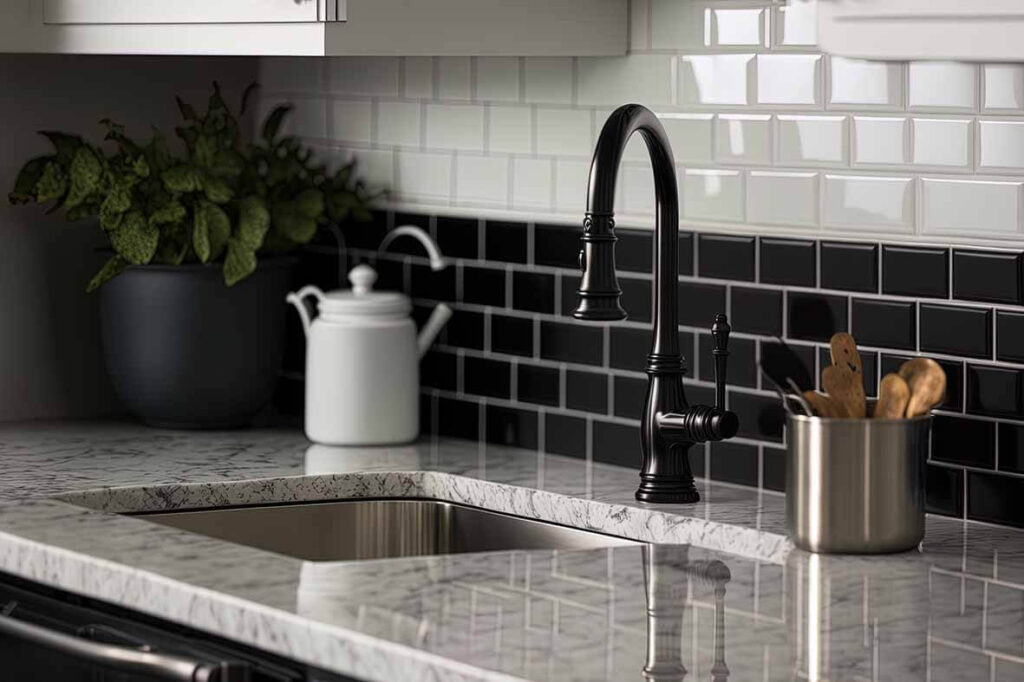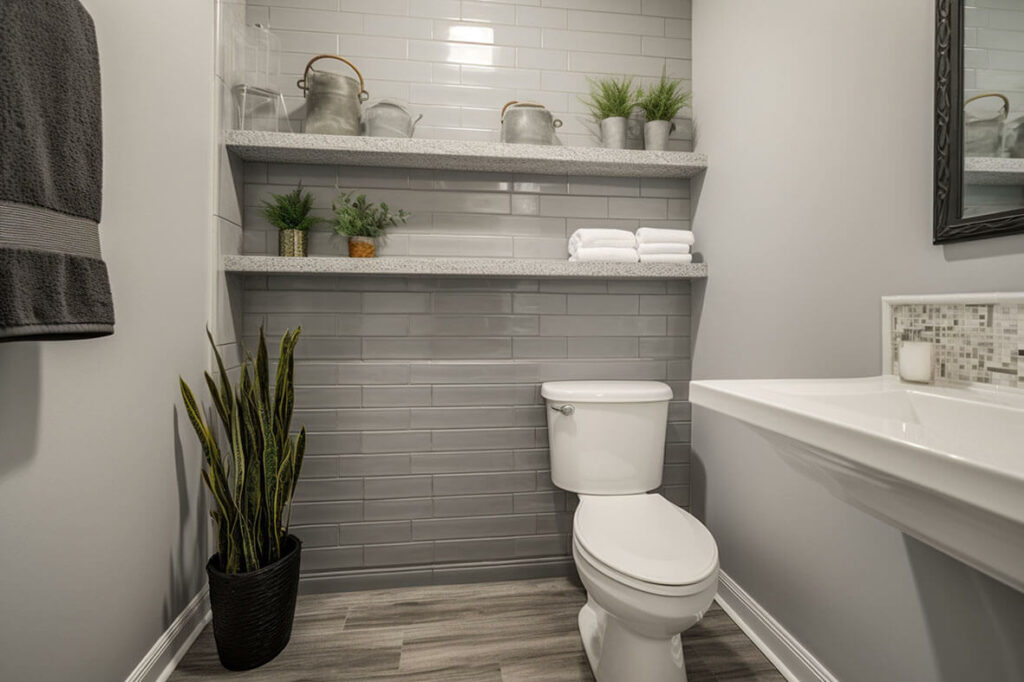When it comes to home renovations, most people will consider adding a subway tile backsplash to their kitchen or bathroom. This is a style you should know how to tile as it is a very popular option for most people in the UK.
This trendy industrial-chic tile is a great way to make a big impact without spending a lot of money. In this blog post, we will teach you how to install subway tile backsplash the right way. We’ll go over everything from choosing the right tiles to cutting and grouting them properly. So, whether you’re a DIY novice or an experienced pro, you’ll be able to tackle this project with ease!


SUBWAY TILE TRENDS
The world’s first subway station, erected in 1904, was designed by George C. Heins and Christopher Grant La Farge, who developed the basic 3 x 6″ ceramic tiles for it. Since then, subway tiles have been used in a variety of public spaces, including hospitals and schools.
In recent years, subway tile has become increasingly popular for use in residential settings as well. This is likely due to the tile’s clean and classic look, which can be incorporated into any design style. Subway tiles are also inexpensive and easy to install, making them a great option for DIYers and professionals.
If you’re considering installing a subway tile backsplash in your home, you’re in good company! This popular design trend is here to stay. It also has a timeless, minimal aesthetic that many homeowners are drawn to.
GET CREATIVE
Traditional subway tile is installed in a straight, horizontal brick pattern. But there are also many creative ways to layout your tiles.
Simply laying them vertically in the same formation adds interest without too much effort, however a herringbone layout is always popular. You can even play with different textured tiles to add to this design, or opt for a double herringbone to add to its visual appeal.
Once you have a general idea of what you want, it’s time to start shopping for tiles! There are many different types of subway tiles on the market, so take your time to find the perfect ones for your space. When you’re ready to install them, just follow the steps below.
HOW TO INSTALL SUBWAY TILE BACKSPLASH
If you want to install a tile backsplash yourself but don’t have much experience, you’ve come to the right place.
Here’s how to install a backsplash, a step-by-step guide:
1 – MEASURE UP
First, measure the area where you’ll be installing the backsplash. Then, calculate how many tiles you’ll need to purchase.
Keep in mind that you’ll also need to buy grout, thin-set mortar, tile spacers, and levelling clips.
Generally, it is recommended that you purchase 10% more tiles than you need, to account for any breakages or mistakes made while installing. If you are a novice, it is ideal to purchase 15% more to allow for more mistakes so you can learn as you go along.
Once you have all your materials, it’s time to…
2 – PREPARE THE WALL
Next, prep the area by removing any old backsplash or wallpaper. If you’re starting with a bare wall, that’s great. Just make sure to clean it thoroughly before proceeding.
Depending on the type of wall, you may want to sand it first. Be sure to use a vacuum to remove any dust and debris from the surface before you start. If it’s a smooth surface, you may be able to skip this step.

3 – FIND THE CENTRE
Once the area is prepped, it’s time to find the centre starting point of your subway tile backsplash.
Starting from a central point in the wall means that the tiles and cuts at both ends will be even.
Measure the wall from both sides to ensure you’ve got an accurate measurement. Now, half it, that’s the centre point on your wall. Measure and mark this point using a pencil and a ruler, or level.
4 – APPLY TILE ADHESIVE
Now you’ve got the centre marked on your wall, it’s time to start applying tile adhesive.
Begin in the centre point at the top or bottom of the wall.
If you’re using thin-set mortar, apply it to the wall with a notched trowel using the notched side to comb grooves in the adhesive in the direction of the short side of the tile. This is the best way to apply the adhesive because it provides the air with the easiest rout possible to get out from under the tile, which improves the adhesion.
Now that the adhesive is applied…
5 – LAY THE SUBWAY TILE BACKSPLASH
Now it’s time to lay the tiles! Start in the same place where you applied the adhesive and work your way out. Be sure to press each tile firmly into place as you go, adding in a spacer to ensure your tiles are evenly spaced apart.
Top Tip! Make sure your tiles are prepped before applying them to your wall. Some tiles need soaking in water or sealing before they are applied, double check this before you start!
Remember that you’ll need to cut some tiles in order to lay them in a staggered pattern in the corners or your wall. You can do this with one of our manual tile cutters.
If the wall isn’t completely flat, you will also need to use levelling clips. Once you’ve laid one row of tiles, slide the levelling clip base under the free edge of the laid tiles (which is where you will place your next row).

Add more adhesive to the wall so you can lay the next row of tiles, and be sure to lay them on top of the levelling clip base. This way, when you add the top of the levelling clip (either wedge or spin cap) each tile can be levelled.
Once all the tiles are in place, you can add your levelling clip top. If you’re using our Delta this is in the form of a wedge, and if you use our Cyclone system this is in the form of a twist cap.
Ensure that the levelling clip is firmly in place and has levelled the tiles. You can check this by using a spirit level across the tilled wall. Now, let the adhesive dry for at least 24 hours.
6 – GROUT BETWEEN THE TILES
After the adhesive has had time to set, it’s time to grout the backsplash. Before you do this tough, you will need to remove the levelling clips you placed the day before when you set your tiles.
To do this, simply knock them out using a mallet in the direction of their joint. This reduces tile chipping greatly. Now you can continue to grout!
Begin by mixing your grout with water according to the manufacturer’s instructions.
Then, using a grout float, apply the grout to the joints between the tiles. Work in small sections and be sure to wipe away any excess grout. You can use a soft wet cloth to ensure all your tiles are clean and your grout is neat.
A common mistake people make is not wiping away the excess grout before it dries. If you don’t, it will be very difficult to remove later. Especially dark grouts on a light tile.
Once the grout is dry…
7 – APPLY TILE SEALER
Allow the grout to dry for 24 hours before using the backsplash area. After that, it’s time to apply tile sealer (optional but recommended). Wait another 24 hours after applying the sealer before using your backsplash.
The benefit of applying tile sealer is that it will make your backsplash easier to clean and protect it from stains.
And that’s it! You’ve successfully installed a subway tile backsplash in your kitchen or bathroom. Now enjoy your handywork and admire your beautiful new space.
SUBWAY TILE BACKSPLASH PRESERVATION ADVICE
We mentioned that tile sealer is optional, but that we recommend using it. That’s because tile backsplashes are constantly exposed to water, grease, and other liquids that can cause staining.
Tile sealant will create an invisible barrier on your backsplash that will help protect it from everyday wear and tear. It’s an easy way to keep your backsplash looking brand new for years to come!
TILE SPACER ADVICE
When you’re laying the tiles in step 5, spacers will help you to create even, consistent joints. We recommend using tile spacers that are at least 2mm wide.
FACTOR IN DRYING TIME
For each step of the process, remember to factor in drying time. If you try to rush ahead without giving the adhesive or grout enough time to dry, you’ll likely end up with a subpar backsplash.
We know that it can be tempting to move on to the next step as quickly as possible. But trust us, it’s worth it to take the time to do things right the first time around.

CAULKING IS IMPORTANT
One last factor to keep in mind is caulking. Caulking is a sealant that helps to fill in gaps and cracks. You’ll want to apply it around the perimeter of your backsplash, as well as any other areas where two different surfaces meet (such as where the backsplash meets the countertop).
Caulking will help create a watertight seal that will keep your backsplash looking great for years to come.
SUBWAY TILE BACKSPLASH INSTALLATION
So, that’s how to install subway tile backsplash! It’s a great way to update your kitchen or bathroom. It’s a relatively simple project that most people can do themselves.
Be sure to follow the steps we outlined above, and you’ll be enjoying your new backsplash in no time.
Keep exploring the RUBI blog for more tips and tricks. We recently wrote an article about how to clean grout perfectly. If you want to spruce up tiles somewhere else in your home, take a look!


Post a comment